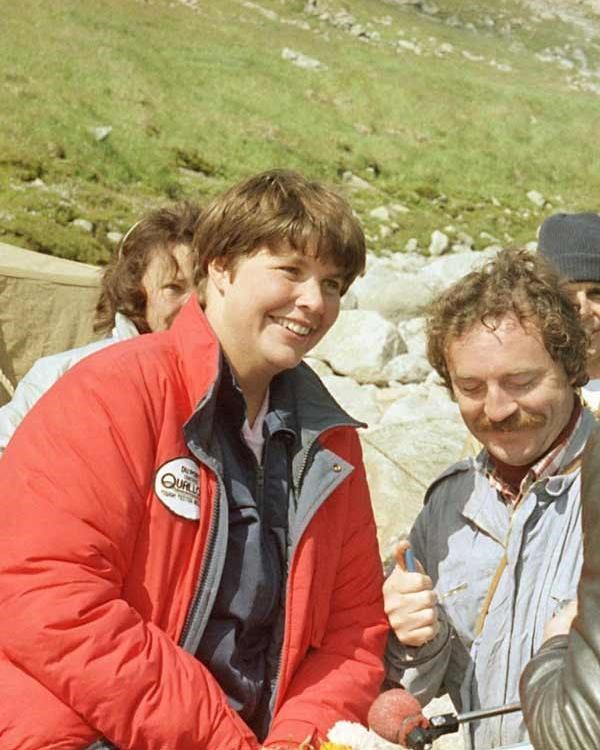Last updated: September 4, 2020
Person
Lynne Cox: The Swim That Lifted the Iron Curtain

Photo: Claire Richardson / AP / East News
Only 2.7 miles separate the Little and Big Diomede Islands in the Bering Strait, but the international border between the US and Soviet Union/Russia made this distance nearly impossible to cross for much of the twentieth century.
On August 7, 1987 the American swimmer Lynne Cox confronted the icy waters of the Bering Strait and the frigid political climate of the Cold War by swimming from the US Little Diomede Island to the Soviet Big Diomede. The swim was a peace gesture, inspired by a dream to bridge the distance between the two countries involved in the Cold War battle.
Cox grew up in a family of swimmers. Her grandfather swam across the Hudson River, and her parents taught her and her brother Dave to swim at early age. At age fifteen, she set a new record for crossing English Channel for both men and women, and three years later became the first woman to swim across Cook Strait, the 13 ½ mile shark-infested body of water between New Zealand’s North and South Islands. Cox conceived the idea to swim across the Bering Strait from the US to Russia in 1976, but it took her eleven years to bring this dream to the reality. Political tensions between US and Soviet Union stalled fundraising, and Soviet authorities were not responding to the swimmer’s request for permission to cross the border.
In 1987, Cox decided that the time had come. With personal funds, some support from friends and family, and a free ticket from Alaska Airlines, she arrived on Little Diomede, but thirty hours before the scheduled swim, there was still no word from the Soviet side. Instead, two large ships appeared in the middle of the strait, to which US responded by sending jet fighters. For a short while it looked like Cox’s peace initiative had taken a very wrong turn. Finally, 24 hours before the scheduled time, permission came from President Gorbachev. This was exciting news to both the swimmer and her local indigenous Inupiaq guides, who were to accompany her in their traditional skin boats and see their relatives on the Russian side for the first time in over forty years.
When the thirty-year-old swimmer finally stepped into the Strait on the foggy morning of August 7, 1987, the 38° F water took her breath away. "The cold was like a huge vampire pulling the heat from my body,” Cox recalled, “I looked down at my fingers and they were totally grey, like the hands of a cadaver." The Inupiaq guides were supposed to guide her to Big Diomede, but none of them had ever been there and with a rusty compass as the only means of navigation, there was a fear that they’d miss their target altogether.
Finally, a Russian support vessel emerged from the fog, a sight that Cox called “one of the most beautiful sights in her life.” The excitement was building, and an English-speaking Soviet journalist informed Cox, that there was a Russian welcoming party waiting for her… half a mile farther than the closest shore point. The freezing swimmer had a tough choice to make. “I decided to go that extra half mile, she says, because I felt like if I touch rock, instead of somebody’s hand, what have I done? “Nothing! There was no connection with the people on the opposite shore.” As she got close to the beach, the people began waving and jumping. “They were so excited,” Cox said, “because they realized that for the first time in 48 years the border was open, and they were there to witness it and greet us.”
When after two hours and five minutes in the water Cox came to shore, she could not pull herself up. She extended her arm and two Russians in military in uniform grabbed her. "I instantly felt this heat from their warm hands,” Cox recalls, “and they were speaking Russian, and I thought, oh my gosh, we really made it!”
In a tent nearby, Soviet doctor Rita Zakarova covered Cox with hot-water bottles, put her in a sleeping bag, and then embraced her. For the American, the moment symbolized the entire trip. For the world, Lynne Cox’s swim across of the Bering Strait symbolized hope for a new era in the US-Russia relationship. When President Gorbachev travelled to Washington to sign a nuclear weapons treaty later that year, he and President Reagan raised a glass to toast the swimmer. "She proved by her courage how close to each other our peoples live," Gorbachev said.
Bering Strait continues to play an important role in the US - Russian relationship. In 1990, Presidents Bush and Gorbachev announced their intention to create an international park spanning the Bering Strait and expand cooperation in the field of environmental protection and the study of global change. The NPS Shared Beringia Heritage Program works to strengthen this cooperation in the Bering Strait region.
Lynne Cox had a long and distinguished career as an endurance swimmer and activist. Today, she continues sharing her experiences as book author, public speaker and educator, motivating audiences by describing how one can overcome extraordinary obstacles by taking risks, working with teams, and ultimately achieving the impossible.
